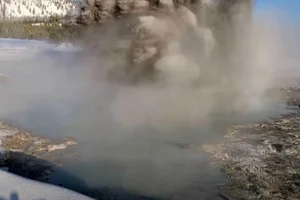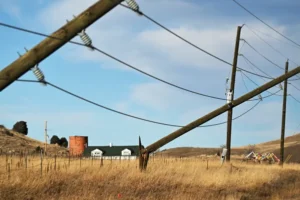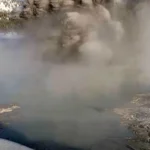Wyoming Receives $13 Million in Federal Funding For Road Projects
Grant will cover final designs for Interstate 80 and Interstate 25 interchange reconstructions
- Published In: Other News & Features
- Last Updated: Jun 29, 2023

Traffic moves slowly along icy stretches of I-80 at the Laramie Range Summit Monday, Jan. 12, 2009 10 miles east of Laramie, Wyo. On Wednesday, the federal government announced it has given the state’s transportation department $13 million for final designs of a trio of highway interchanges in Cheyenne. (AP Photo/ Andy Carpenean)
By K.L. McQuaid
Special to the Wyoming Truth
The federal government on Wednesday announced it has given the state’s transportation department $13 million for final designs of a trio of highway interchanges in Cheyenne.
The current interchanges on Interstate-80, Interstate-25 and the adjacent I-25/U.S. Highway 30 are considered outdated and unable to effectively handle current tractor-trailer and freight traffic.
Federal officials, in approving the grant to Wyoming, said the projects are intended to reduce fatalities and injuries and “restore and modernize infrastructure that are in poor condition and have met the useful life,” according to a 2023 report.
The road projects also are aimed at improving “economic competitiveness by facilitating tourism opportunities through improved access to Frontier Park and historic attractions.”
The money, from the U.S. Department of Transportation (U.S. DOT), came through the Rebuilding American Infrastructure with Sustainability and Equity (RAISE) program, federal officials said.
“This round of RAISE grants is helping create a new generation of good-paying jobs in rural and urban communities alike, with projects whose benefits will include improving safety, fighting climate change, advancing equity, strengthening our supply chain and more,” U.S. Department of Transportation Secretary Pete Buttigieg said in a statement.
Wyoming Department of Transportation (WYDOT) officials said the projects would be some of the most comprehensive – and expensive – built since the federal highway system was completed in the state in 1985.
“These projects would require a substantial amount of capital, and we would likely have to seek sources for that,” Doug McGee, a WYDOT spokesman, told the Wyoming Truth.
“We estimate that they would require hundreds of millions of dollars to complete, but we’re hoping the design work will give us a better idea of the actual amount.”
In all, $2.26 billion in grant money was awarded to fund projects in all 50 states, the District of Columbia and two U.S. territories. Over $15 billion in grants had been sought in total.
The RAISE grant marked the third time in as many days that the federal government has announced significant funding for a Wyoming infrastructure or transportation project.
Earlier this week, federal officials awarded WYDOT nearly $1 million for the purchase of four electric, zero-emission buses for the Teton Village Association Improvement and Service District, to replace aging diesel-engine buses. That grant was included in $1.7 billion in transportation funding overall.
And on Tuesday, the Biden administration unveiled plans to give Wyoming nearly $348 million to expand high-speed internet and broadband service in the state – part of a $42 billion effort to increase connectivity access nationwide.
All three allocations stem from the Bipartisan Infrastructure Law, which President Biden signed in November 2021.
Many of the six states bordering Wyoming fared better in the latest round of funding, with Colorado receiving the most money at $72.1 million for six different projects. In all, Colorado, Idaho, Montana, Nebraska, South Dakota and Utah received a total of $169 million to finance 17 separate roadway, bridge and other related projects, according to the RAISE report.
The RAISE grant program split its f 2023 funding equally among rural and urban communities, with about 70% of the money being dedicated to projects in regions defined as an area of persistent poverty or a historically disadvantaged community, U.S. DOT indicated.
RAISE also allows communities to obtain funding for projects “that are harder to support through other U.S. DOT grant programs,” the agency stated.













